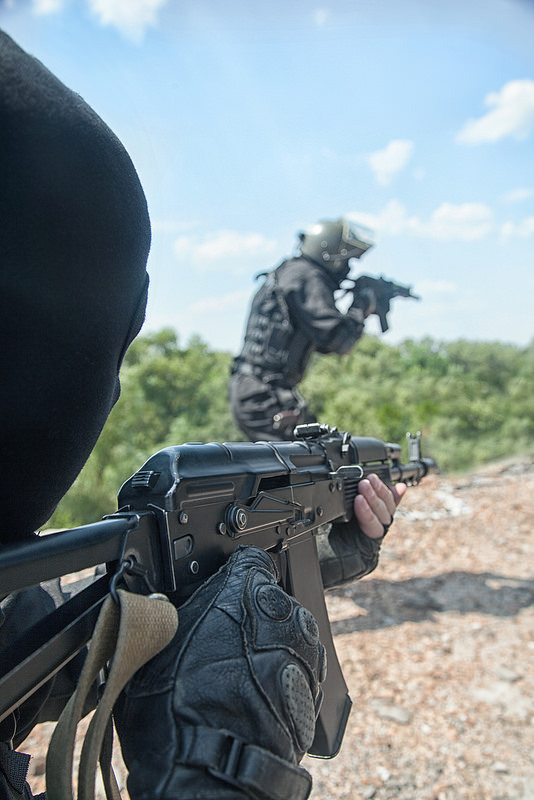#Ukrainian Special Forces
Text
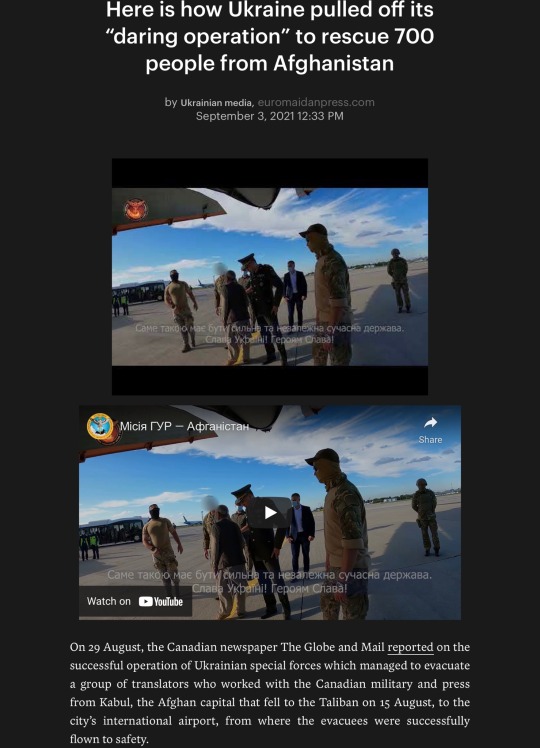
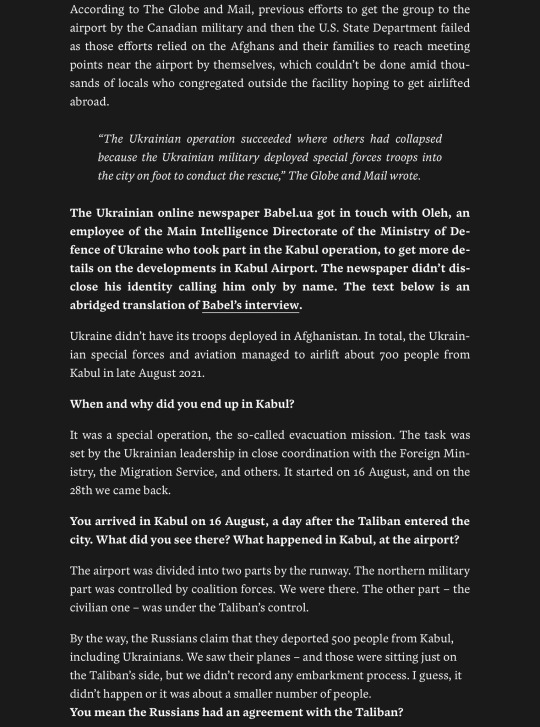
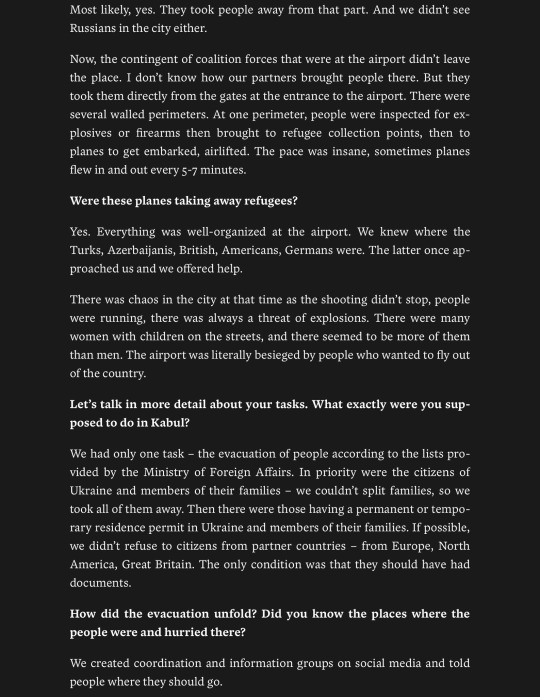
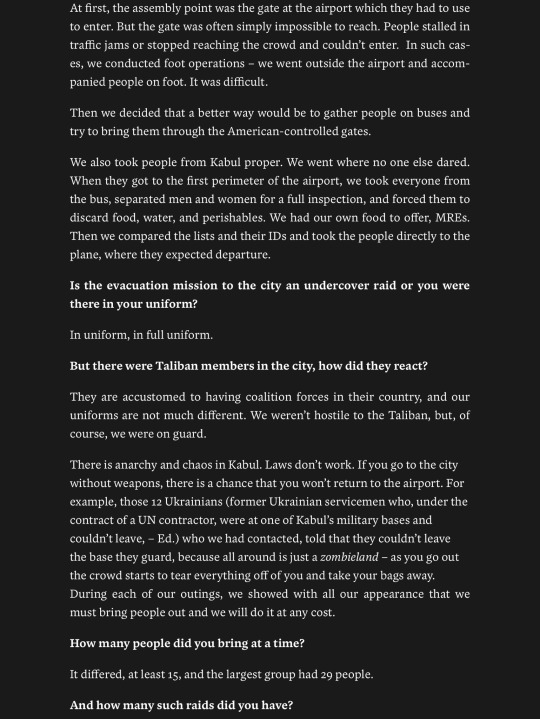
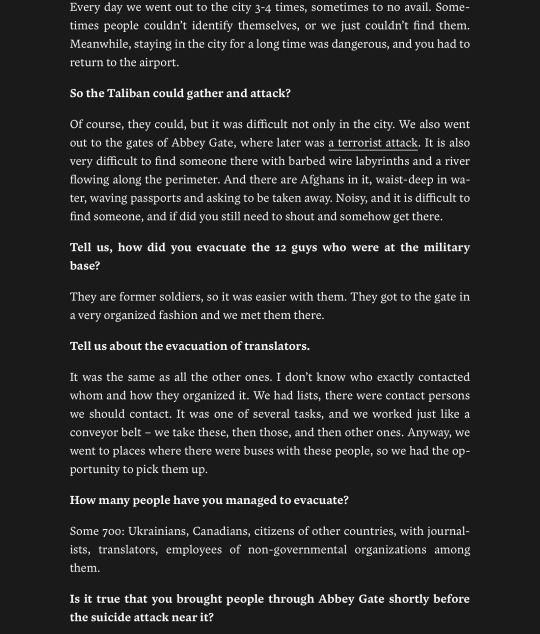
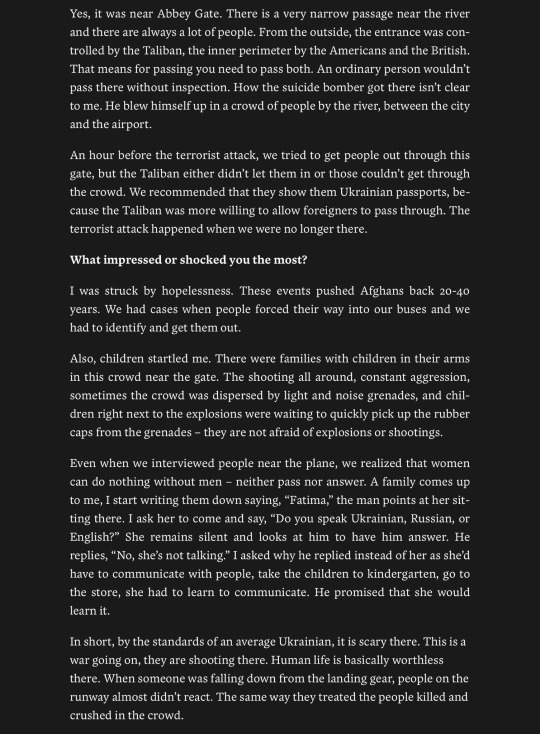
Source: https://euromaidanpress.com/2021/09/03/here-is-how-ukraine-pulled-off-its-daring-operation-to-rescue-700-people-from-afghanistan/
#Ukraine#Ukrainian special forces#they were always badass#this reminds me so much of when Ze said that Ukrainians always helped other people#it seems like Ukrainians are more willing to take risks in order to save lives than others are#in that way it kind of reminds me of the helicopter flights to Azovstal#I’m not saying it’s the same thing#I just don’t think most other people would have done either operation#I do wonder though how it all came to be#sounds to me like the Ukrainians wanted to save their people#and other countries either became aware or were made aware of the operation#and then just said ‘hey we have people there too - would you take them with you pretty please?’#wonder if they got credit for it afterwards
8 notes
·
View notes
Text
🇷🇺⚔️🇺🇦 🚨
INTENSE BATTLES AS RUSSIAN FORCES BREAK THROUGH UKRAINIAN DEFENSES NEAR ROBOTINO IN ZAPOROZHYE
📹 Ukrainian footage showing the breakthrough of Russian Forces of Ukraine's defensive belt near the village of Robotino in the Zaporozhye sector.
Russian Forces from the Southern Military District and Airborne Forces launch a powerful attack on the Ukrainian defensive belt, pushing more than 2km into Ukrainian-held territory, won through great sacrifice during last year's Ukrainian offensive in the Zaporozhye direction.
In the footage, Ukrainian forces destroy several pieces of Russian equipment and systems, though it does little to slow the Russian advance, with one tank being hit directly, only to storm forward mostly undamaged.
Russian landing forces then disembark from armored vehicles under BMP suppressive fire and secure several enemy positions.
Russian Forces manage to breakthrough into the village of Robotino, capturing positions of the Armed Forces of Ukraine and capturing or killing many Ukrainian militants.
In another operation, Russian Forces also announced the capture of the village of Pobeda, south of the recently captured city of Marinka in the South Donetsk direction.
“In the Donetsk direction, units of the Southern Group of Forces liberated the village of Pobeda,” the Russian Ministry of Defense said.
According to the Ministry of Defense, Ukrainian forces in the South Donetsk direction lost over 410 servicemembers, one tank, three armored vehicles, five military vehicles, one Polish-made Krab and one Bogdan self-propelled artillery systems, one D-20 howitzer, and a self-propelled Gvozdika artillery system.
#source
#videosource
@WorkerSolidarityNews
#ukraine#ukraine news#ukraine war#russia#russian federation#russia news#russian news#russo ukrainian war#russia ukraine war#russia ukraine conflict#russia ukraine crisis#war in ukraine#special military operation#russian military#russian armed forces#armed forces of ukraine#ukrainian military#military news#war#eastern europe#europe#europe news#politics#news#geopolitics#world news#global news#international news#breaking news#current events
10 notes
·
View notes
Text
Воїни ССО ЗСУ за допомогою дронів продовжують нищити рашистських окупантів та їхню техніку
Воїни Сил спеціальних операцій Збройних Сил України за допомогою дронів продовжують нищити рашистських окупантів та їхню техніку.
_________
With help of drones, warriors of the Special Operations Forces of the Armed Forces of Ukraine are continuing to destroy the russian nazis and their military equipment.
Втрати Росії в Україні – бійці ССО показали, як нищать окупантів та їх техніку на…

View On WordPress
#Armed Forces of Ukraine#Drone#БПЛА#Безпілотник#БпАК#Дрон#ЗСУ#Збройні Сили України#Російське вторгнення в Україну#Російсько-українська війна#ССО#Сили спеціальних операцій#FPV-дрон#Russo-Ukrainian War#Special Operations Forces
2 notes
·
View notes
Photo
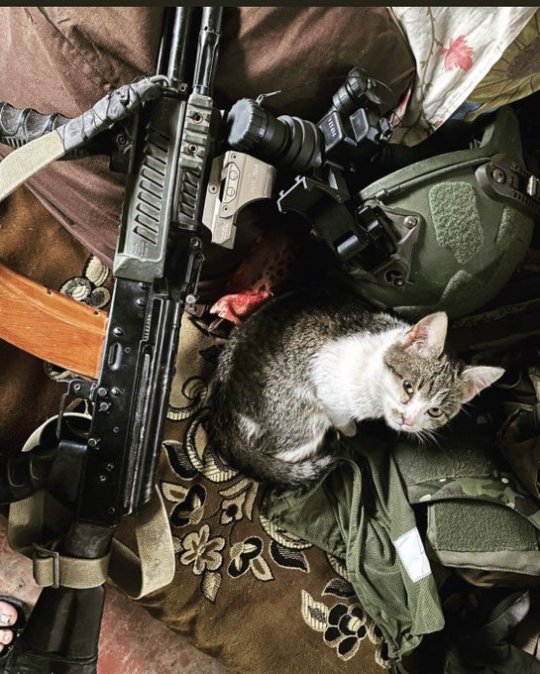
Ukrainian Special Forces Cat
Everyone doing their part!
#2022 russian invasion of ukraine#2022 russia-ukraine news#ukraine#russia#Ukrainian Special Forces Cat#cat#caturday#cats and guns#war cat#war animals#cute#war#world at war#weapons#fun#funny#comedy#humor#lol#haha
18 notes
·
View notes
Text

24 notes
·
View notes
Text

#war#russo ukrainian war#millitary#frontliners#ukraine conflict#europe#russia#soldier#special forces#ukraine
3 notes
·
View notes
Text
Huge explosion as £1billion Russian missile base blown up by Ukrainian special forces in 2nd night of strikes on Crimea | In Trend Today
Huge explosion as £1billion Russian missile base blown up by Ukrainian special forces in 2nd night of strikes on Crimea
Read Full Text
or
Full Article on MAG NEWS
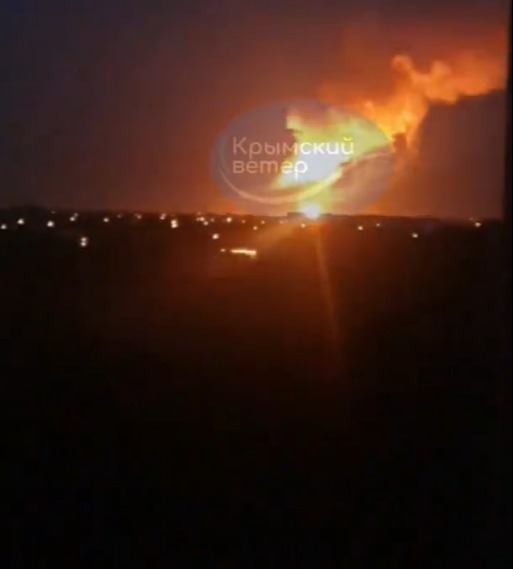
View On WordPress
#Celebrities#Huge explosion as £1billion Russian missile base blown up by Ukrainian special forces in 2nd night of strikes on Crimea#Money#Motors#Politics#ShowBiz#Sport#Tech#Trends#UK#US#World
0 notes
Text
Huge explosion as £1billion Russian missile base blown up by Ukrainian special forces in 2nd night of strikes on Crimea | In Trend Today
Huge explosion as £1billion Russian missile base blown up by Ukrainian special forces in 2nd night of strikes on Crimea
Read Full Text
or
Full Article on MAG NEWS
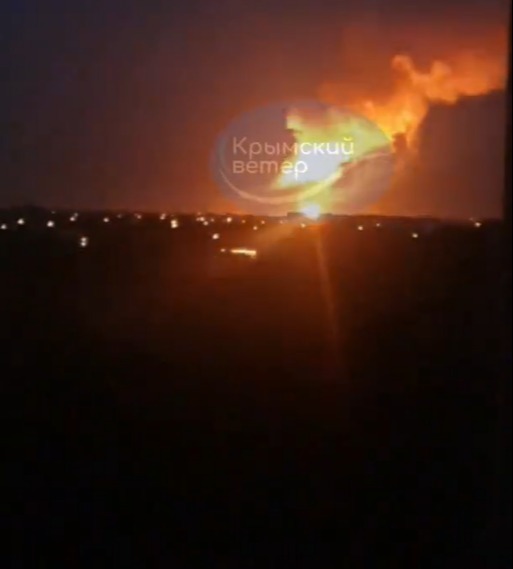
View On WordPress
#Celebrities#Huge explosion as £1billion Russian missile base blown up by Ukrainian special forces in 2nd night of strikes on Crimea#Money#Motors#Politics#ShowBiz#Sport#Tech#UK#US#World
0 notes
Text
fun facts about (polish) vampire folklore because i'm too autism
(disclaimer: my source for all of this is the book "Upiór. Historia naturalna" by Łukasz Kozak i'm not pulling this out of my ass)
The word "vampire" came from a mistranscribed Serbian word, written down by Austrian officials informing about a panic among the locals, who claimed that during a plague their dead were rising and biting them and spreading the plague further
In Poland, the words used to describe what later transformed into a "vampire" in literature were: upiór (and variations thereof - the word came from Ukrainian, and the Ukrainians got it from Turkish "ubyr"), strzyga (f)/strzygoń (m) and wieszczy (m)/wieszczyca (f). "Upiór" was used in the southeast, "strzyga" around the central regions, "strzygoń" (as well as strzyga) specifically in Lesser Poland (Małopolska) and "wieszczy" in Greater Poland (Wielkopolska) and in Kashubia. "Wąpierz" was not a word until some writer in the 19th century made it up!
The upiór actually very rarely drank blood. It happened, sure, but a much more bloodthirsty creature was zmora/mara. However, upiory often drank milk, stealing it from cows and horses. Both are life-giving bodily fluids, after all.
The above might make you think about witches, who were often blamed with stealing or spoiling milk, and you wouldn't be far off. You see, you had to be born as an upiór (these ones weren't contagiously biting!), and while you were alive, it would give you various magical powers, like clairvoyance and detecting the dead upiory, and so the upiór was practically a synonym of a sorcerer or witch. Of course, the sources vary, but depending on who you asked, they could control weather bringing heavy rains or droughts, see the future, know literally everything and so on. Those so-called "living vampires" knew who they were since birth and were often helpful, until they died.
After an upiór died, that's when the bad things happened. They disappeared from their graves, destroyed churches, broke candles, brought plague upon the people, scared their neighbors, and if one puffed in your face, you would soon die. They were said to be able to walk around with their decapitated head, so anti-vampiric burials often had to be very thorough and decapitation wasn't enough.
The signs that were supposedly telling of a living vampire were, among others: being born with teeth, being born in a caul, not having armpit or pubic hair BUT having a hairy chest, not having undergone confirmation (i'll come back to that in a moment), having a very red face and easily and often blushing (not being pale!), or being born with a deformed foot.
Not having participated in the confirmation sacrament was especially damning, because it was believed that upiory had two souls (and two hearts). When they were baptized, only one soul was being saved, and the confirmation sacrament was supposed to protect the second soul. This, of course, was extremely against the catechism, so the first "official", church-related sources recording those beliefs had to invent another "backstory" for upiory, and they claim that an upiór is a dead person specifically, who was given to the devil at birth, the baptism saving their soul, but their body still belonging to the dark forces, which was why they rose from their graves - the devil basically hijacked their corpses.
I won't make this post much longer but I will GLADLY answer any questions because this is my special interest and I just came back from an exhibition where the author of the aforementioned book talked about all of that so. me right now ⬇️ (readmore so you dont get continuously blased with the gif under it)

631 notes
·
View notes
Photo

Two years of Russian invasion of Ukraine
by theflagmapguy_2.0
On 24 February 2022, Russia invaded Ukraine in a major escalation of the Russo-Ukrainian War, which began in 2014. The invasion has caused tens of thousands of deaths on both sides and instigated Europe's largest refugee crisis since World War II. About 8 million Ukrainians were displaced within their country by June, and more than 8 million fled the country by February 2023. After the Revolution of Dignity in 2014, Russia annexed Crimea and Russian-backed paramilitaries seized the Luhansk and Donetsk oblasts of Ukraine's Donbas region, sparking a regional war. In March 2021, Russia began a military build-up, amassing up to 190,000 soldiers at Ukraine's borders. Russian government officials denied plans to attack Ukraine until the day before the invasion. On 21 February 2022, Russia recognised the Donetsk People's Republic and the Luhansk People's Republic, two self-proclaimed breakaway quasi-states in the Donbas. The next day, the Federation Council of Russia authorised the use of military force and Russian soldiers entered both territories. The invasion began the morning of 24 February 2022 upon Russian president Vladimir Putin's announcement of a "special military operation" seeking the "demilitarisation" and "denazification" of Ukraine. In his address, Putin espoused irredentist views, challenged Ukraine's right to statehood, and falsely claimed that Ukraine was governed by neo-Nazis who persecuted the ethnic Russian minority. Minutes later, Russian air strikes and a ground invasion were launched along a northern front from Belarus towards Kyiv, a north-eastern front towards Kharkiv, a southern front from Crimea, and a south-eastern front from Donetsk and Luhansk. In response, Ukrainian president Volodymyr Zelenskyy enacted martial law and a general mobilisation.
211 notes
·
View notes
Text
🇺🇦🇬🇧 🤡 🚨
DAVYD ARAKHAMIA CONFIRMS RUSSIAN PRESIDENT'S CLAIM THAT BORIS JOHNSON ENDED DEAL BETWEEN RUSSIA AND UKRAINE
Davyd Arakhamia, a leader in Zelensky's Servant of the People's Party in Ukraine, confirmed in an interview with Ukrainian media that the narrative that Russian President Vladimir Putin has been consistently pushing is in fact correct.
Arakhamia said in the interview that a deal had been worked out between the Ukrainian leadership and the Russian authorities in April of 2022, shortly after the start of Russia's Special Military Operation.
That deal, which called for a neutral Ukraine, had been accepted by Kiev, and the Ukrainian leadership had begun reviewing the details of the agreement when U.K. Prime Minister Boris Johnson rushed to Kiev to order the Ukrainians not to sign onto the deal with the Russians, but instead to fight them in a war, confident that the West could provide enough training and weapons to defeat the Russian Federation on a modern battlefield.
That story has been repeatedly told by the Russian President to the media, as have other Russian officials, but until now, Western leaders like Joe Biden, Boris Johnson and Rishi Sunak denied the claim, calling it "Russian propaganda".
Now, Davyd Arakhamia has accepted this version of events, confirming for the media the arrival of Boris Johnson to Ukraine, telling the reporter, "they [the Russians] were ready to end the war."
"If we accepted neutrality, like Finland once did, and we would make a commitment that we will not join NATO," Arakhamia said, adding that "when we returned from Instanbul, Boris Johnson came to Kiev and said that we will not sign anything with them at all and let's just go to war. As soon as we call them to sit down and negotiate, they [the Russians] will form a delegation the next day waiting for us."
This not only confirms the Russian President's version of events, it also confirms the West's commitment to war, and its commitment to damaging the Russian military and economy through any of the most destructive means possible.
#source
@WorkerSolidarityNews
#ukraine#boris johnson#uk#russia#special military operation#war in ukraine#ukraine war#ukraine news#ukrainian politics#armed forces of ukraine#russian armed forces#vladimir putin#davyd arakhamia#us news#uk news#ukrainian media#war#eastern europe#europe#europe news#european news#politics#news#geopolitics#world news#global news#international news#breaking news#current events#war news
17 notes
·
View notes
Text
На Сумському напрямку воїни ССО ЗСУ знищили ПЗУ ЗРК «Бук» рашистських загарбників
На Сумському напрямку воїни Сил спеціальних операцій Збройних Сил України за допомогою ударних дронів знищили пуско-заряджальну установку з шістьма ракетами зенітно-ракетного комплексу “Бук-М1” рашистських загарбників, вогневу установку цього комплексу – пошкодили.
_________
With help of strike drones, at Sumy sector, warriors of the Special Operations Forces of the Armed Forces of Ukraine…
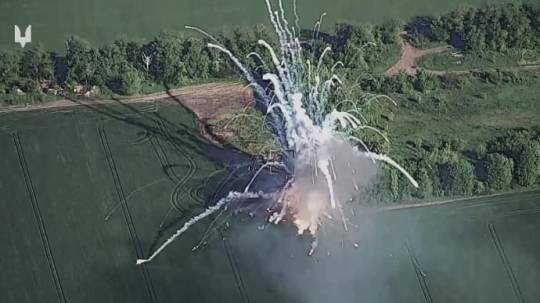
View On WordPress
#Armed Forces of Ukraine#Drone#БПЛА#БпАК#Дрон#ЗСУ#Збройні Сили України#Російське вторгнення в Україну#Російсько-українська війна#ССО#Сили спеціальних операцій#Russo-Ukrainian War#Special Operations Forces
0 notes
Photo
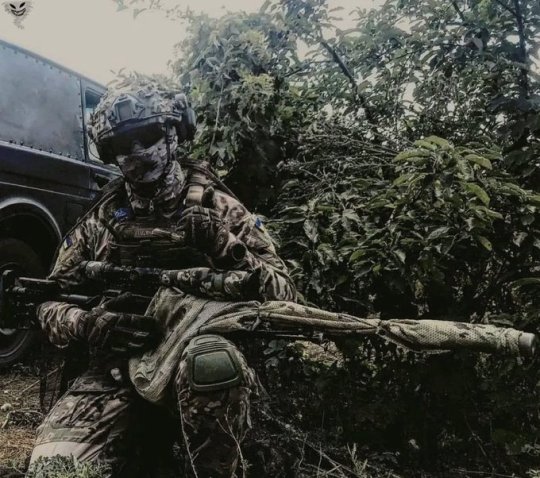
Ukrainian Special Forces Sniper
Ice Cold ❄️
#2022 russian invasion of ukraine#2022 russia-ukraine news#ukraine#russia#Ukrainian Special Forces Sniper#sniper rifle#assault rifle#war#world at war#weapons#battle#fighting
11 notes
·
View notes
Text
Huge explosion as £1billion Russian missile base blown up by Ukrainian special forces in 2nd night of strikes on Crimea | In Trend Today
Huge explosion as £1billion Russian missile base blown up by Ukrainian special forces in 2nd night of strikes on Crimea
Read Full Text
or
Full Article on MAG NEWS
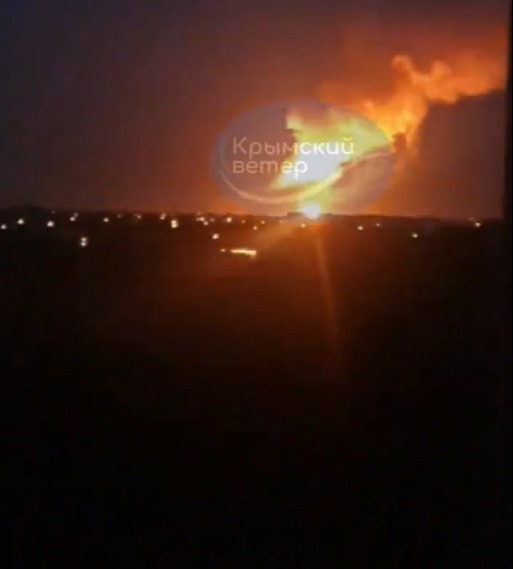
View On WordPress
#Celebrities#Huge explosion as £1billion Russian missile base blown up by Ukrainian special forces in 2nd night of strikes on Crimea#Money#Motors#Politics#ShowBiz#Sport#Tech#Trends#UK#US#World
0 notes
Text
Ivan and Phoebe by Oksana Lutsyshyna
Ivan and Phoebe is a novel about a revolution of consciousness triggered by very different events, both global and personal. This is a book about the choices we make, even if we decide to just go with the flow of life. It is about cruelty, guilt, love, passion – about many things, and most importantly, about Ukraine of the recent past, despite or because of which it has become what it is today.
The story told in Oksana Lutsyshyna’s novel Ivan and Phoebe is set during a critical period – the 1990s. In the three decades that have passed since gaining independence, Ukraine has experienced many socio-political, economic, and cultural changes that have yet to be fully expressed. The Revolution of Dignity in 2014 marked a pivotal moment in the country’s history, as it signaled a shift towards European integration and a strong desire to distance itself from Moscow. Prior to this, Ukrainian culture had remained overshadowed by Russian influence, struggled to compete for an audience and was consequently constrained in exploring vital issues.
77 days of February. Living and dying in Ukraine
"77 Days," is a compelling anthology by contributors to Reporters, a Ukrainian platform for longform journalism. The book, published in English as both an e-book and an audiobook by Scribe Originals.
"77 Days'' offers a tapestry of styles and experiences from over a dozen contributors, making it a complex work to define. It includes narratives about those who stayed put as the Russians advanced, and the horror they encountered, like Zoya Kramchenko’s defiant "Kherson is Ukraine," Vira Kuryko’s somber "Ten Days in Chernihiv," and Inna Adruh’s wry "I Can’t Leave – I’ve Got Twenty Cats." The collection also explores the ordeal of fleeing, as in Kateryna Babkina’s stark "Surviving Teleportation '' and "There Were Four People There. Only the Mother Survived."
It also highlights tales of Ukrainians who created safe havens amidst the turmoil, such as Olga Omelyanchuk’s "Hippo and the Team," about zookeepers safeguarding animals in an occupied private zoo near Kyiv, and one of Paplauskaite’s three pieces, "Les Kurbas Theater Military Hostel," depicting an historic Lviv theater turned shelter for the displaced, including the writer/editor herself.
In the Eye of the Storm. Modernism in Ukraine 1900’s – 1930’s
This book was inspired by the exhibition of the same name that took place in Madrid, at the Museo Nacional Thyssen-Bornemisza, and is currently at the Museum Ludwig, located in Cologne, Germany.
Rather than being a traditional catalogue, the publishers and authors took a more ambitious approach. Rather than merely publishing several texts and works from the exhibition, they choose to showcase the history of the Ukrainian avant-garde in its entirety – from the first avant-garde exhibition in Kyiv to the eventual destruction of works and their relegation to the "special funds" of museums, where they were hidden from public view.
These texts explain Ukrainian context to those who may have just learned about the distinction between Ukrainian and Russian art. Those "similarities" are also a product of colonization. It was achieved not only through the physical elimination of artists or Russification – artists were also often forced to emigrate abroad for political or personal reasons. Under the totalitarian regime, discussing or remembering these artists was forbidden. Archives and cultural property were also destroyed or taken to Russia.
"The Yellow Butterfly" by Oleksandr Shatokhin
"The Yellow Butterfly" is poised to become another prominent Ukrainian book on the themes of war and hope. It has been listed among the top 100 best picture books of 2023, according to the international art platform dPICTUS.
The book was crafted amidst the ongoing invasion. Oleksandr and his family witnessed columns of occupiers, destroyed buildings, and charred civilian cars. Shatokhin describes the book’s creation as a form of therapy, a way to cope with the horrors. "During this time my vision became clearer about what I wanted to create – a silent book about hope, victory, the transition from darkness to light, something symbolic," he explains.
Although "The Yellow Butterfly" is a wordless book, today its message resonates with readers across the globe.
A Crash Course in Molotov Cocktails by Halyna Kruk
A Crash Course in Molotov Cocktails is a bilingual poetry book (Ukrainian and English) about war, written between 2013 and 2022, based on Halyna’s experience as an author, volunteer, wife of a military man and witness to conflict.
The Ukrainian-speaking audience is well-acquainted with Halyna Kruk – a poet, prose author and literature historian. Kruk is increasingly active on the international stage, with her poetry featured in numerous anthologies across various languages, including Italian, French, Swedish, Norwegian, Portuguese, Spanish, Polish, English, German, Lithuanian, Georgian and Vietnamese.
For an English-speaking audience, her poetry unveils a realm of intense and delicate experiences, both in the midst of disaster and in the anticipation of it. The poems are succinct, direct, and highly specific, often depicting real-life events and individuals engaged in combat, mourning, and upholding their right to freedom.
130 notes
·
View notes
